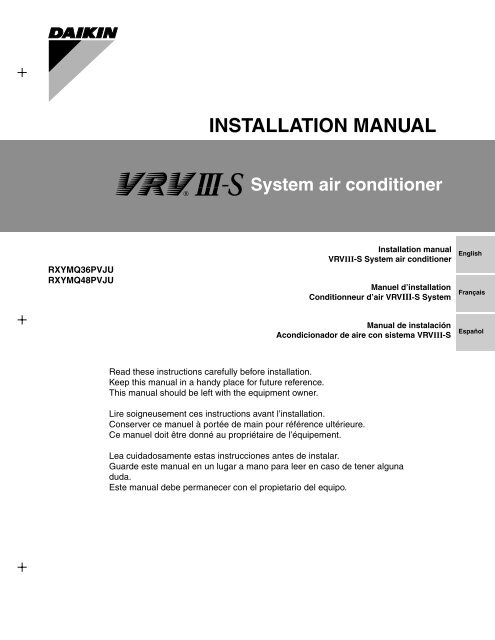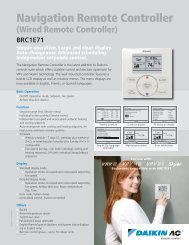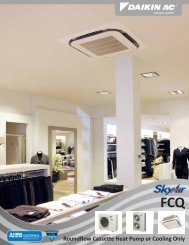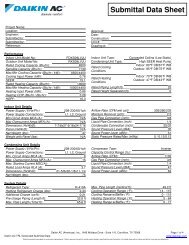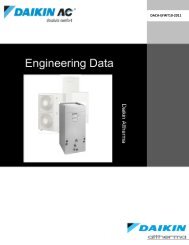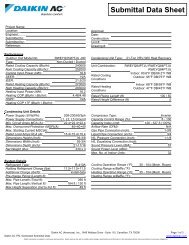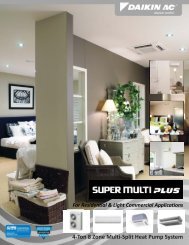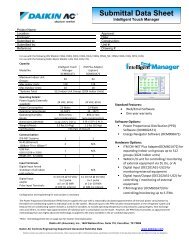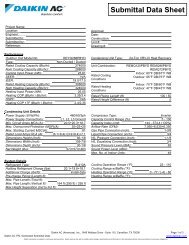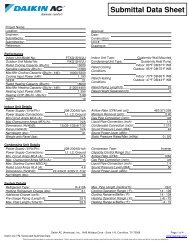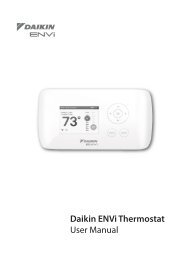INSTALLATION MANUAL - Daikin AC
INSTALLATION MANUAL - Daikin AC
INSTALLATION MANUAL - Daikin AC
- No tags were found...
Create successful ePaper yourself
Turn your PDF publications into a flip-book with our unique Google optimized e-Paper software.
<strong>INSTALLATION</strong> <strong>MANUAL</strong>System air conditionerRXYMQ36PVJURXYMQ48PVJUInstallation manualVRVIII-S System air conditionerManuel d’installationConditionneur d’air VRVIII-S SystemEnglishFrançaisManual de instalaciónAcondicionador de aire con sistema VRVIII-SEspañolRead these instructions carefully before installation.Keep this manual in a handy place for future reference.This manual should be left with the equipment owner.Lire soigneusement ces instructions avant l’installation.Conserver ce manuel à portée de main pour référence ultérieure.Ce manuel doit être donné au propriétaire de l’équipement.Lea cuidadosamente estas instrucciones antes de instalar.Guarde este manual en un lugar a mano para leer en caso de tener algunaduda.Este manual debe permanecer con el propietario del equipo.
1236 712 34 58figure 1figure 21412565(in.)260 or more440 or more40 or more360 or more60 or more23figure 3figure 4[1] [2][1] [2]20 ormore40 ormore20 ormore40 ormore[3]4 or more4 or more4 or more4 or more[3]4 or more6 ormore6 ormore6 or more20 ormore40 ormore4 or more40 ormore(in.)8 or more12 or more(in.)8 ormore12 or morefigure 5 figure 6[1] [2][1] [2]LHLH20 or more[3] [4]20 ormore40 ormore40 or more20 ormore40 ormoreL > H20 orless20 ormore4 ormoreL > H[3] [4]40 ormore20 orless40 ormore40 or more12 ormore(in.)20 or more40 or more(in.)HAL10 ormoreHAL12 ormorefigure 7 figure 8
L[5] [6] [7] [8]L > H(in.)20 ormoreH4 ormoreL40 ormoreAHL20 ormore40 ormoreAH40 ormoreL20 ormore60 ormoreAH40 ormorefigure 8[1]Z[1][2]40 or more4[2]40 ormore8 ormore80 ormore4 ormore23167(in.)Z412 or more(in.)H60 ormore24 ormore120 ormoreLA45figure 9 figure 10figure 14(in.)115/16123475612534356 6 64 4 48 8 87 7 7figure 11 figure 12figure 1587115 1/2 24 3/8 5 1/211 3/88 5/84 5/81 3/416 5/8313 3/4(13 5/8~14)4324 1/8(in.)21262425figure 13figure 16figure 17
381TO IN/D UNIT TO OUT/D UNITF1 F2 F1 F241 26710112F1 F2F1 F23F1 F2F1F2F1F2F1F2F1F2F1F2figure 19figure 20521L1 L234 19112374A5628Bfigure 18figure 2111 24653487652434123421figure 22 figure 23 figure 24 figure 25216121911 81073234564 5figure 26 figure 27 figure 281238746512310475896figure 29 figure 30
RXYMQ36PVJURXYMQ48PVJU VRVIII-S System air conditioner Installation manualCONTENTS1. SAFETY CONSIDERATIONS.................................................. 12. INTRODUCTION...................................................................... 22-1. Combination...................................................................... 32-2. Standard operation limit .................................................... 32-3. Spec list ............................................................................ 32-4. Electrical properties .......................................................... 32-5. Standard supplied accessories ......................................... 32-6. Option accessory .............................................................. 33. BEFORE <strong>INSTALLATION</strong>........................................................ 34. SELECTING <strong>INSTALLATION</strong> SITE ......................................... 45. PRECAUTIONS ON <strong>INSTALLATION</strong> ...................................... 56. FIELD WIRING......................................................................... 66-1. Wiring connection example for whole system................... 66-2. How to lay the power supply wiring andtransmission wiring............................................................ 66-3. How to connect the power supply wiring........................... 76-4. Transmission wiring connection procedure....................... 77. PRECAUTIONS ON REFRIGERANT PIPING......................... 77-1. Installation tools ................................................................ 77-2. Selecting piping material................................................... 87-3. Protection against contamination when installing pipes ........ 87-4. Pipe connection ................................................................ 87-5. Connecting the refrigerant piping...................................... 87-6. Heat insulation of piping.................................................... 97-7. Example of connection.................................................... 107-8. Air tight test and vacuum drying...................................... 118. ADDITIONAL REFRIGERANT CHARGE .............................. 128-1. Before adding refrigerant ................................................ 128-2. Checking the refrigerant tank.......................................... 128-3. Adding refrigerant ........................................................... 129. POST-WORK CHECKS......................................................... 1210. TEST RUN ............................................................................. 1210-1.Power On–Check Operation.......................................... 1210-2.Temperature control operation checklist........................ 1311. CAUTION FOR REFRIGERANT LEAKS............................... 141. SAFETY CONSIDERATIONSRead these “SAFETY CONSIDERATIONS for Installation” carefullybefore installing air conditioning equipment. After completing the installation,make sure that the unit operates properly during the startup operation.Instruct the customer on how to operate and maintain the unit. Informcustomers that they should store this Installation Manual with the OperationManual for future reference.Always use a licensed installer or contractor to install this product.Improper installation can result in water or refrigerant leakage, electricalshock, fire, or explosion.Meanings of DANGER, WARNING, CAUTION, and NOTE Symbols:DANGER.......Indicates an imminently hazardous situation which,if not avoided, will result in death or serious injury.WARNING.....Indicates a potentially hazardous situation which, ifnot avoided, could result in death or serious injury.CAUTION ......Indicates a potentially hazardous situation which, ifnot avoided, may result in minor or moderate injury.It may also be used to alert against unsafe practices.NOTE.............Indicates situations that may result in equipment orproperty-damage accidents only.DANGER• Refrigerant gas is heavier than air and replaces oxygen. A massiveleak can lead to oxygen depletion, especially in basements,and an asphyxiation hazard could occur leading toserious injury or death.• Do not ground units to water pipes, gas pipes, telephone wires,or lightning rods as incomplete grounding can cause a severeshock hazard resulting in severe injury or death. Additionally,grounding to gas pipes could cause a gas leak and potentialexplosion causing severe injury or death.• If refrigerant gas leaks during installation, ventilate the areaimmediately. Refrigerant gas may produce toxic gas if it comesin contact with fire. Exposure to this gas could cause severeinjury or death.• After completing the installation work, check that the refrigerantgas does not leak throughout the system.• Do not install unit in an area where flammable materials arepresent due to risk of explosions that can cause serious injuryor death.• Safely dispose all packing and transportation materials inaccordance with federal/state/local laws or ordinances. Packingmaterials such as nails and other metal or wood parts, includingplastic packing materials used for transportation may causeinjuries or death by suffocation.WARNING• Only qualified personnel must carry out the installation work.Installation must be done in accordance with this installationmanual. Improper installation may result in water leakage, electricshock, or fire.• When installing the unit in a small room, take measures to keepthe refrigerant concentration from exceeding allowable safetylimits. Excessive refrigerant leaks, in the event of an accident ina closed ambient space, can lead to oxygen deficiency.• Use only specified accessories and parts for installation work.Failure to use specified parts may result in water leakage, electricshocks, fire, or the unit falling.• Install the air conditioner on a foundation strong enough that itcan withstand the weight of the unit. A foundation of insufficientstrength may result in the unit falling and causing injuries.• Take into account strong winds, typhoons, or earthquakeswhen installing. Improper installation may result in the unit fallingand causing accidents.• Make sure that a separate power supply circuit is provided forthis unit and that all electrical work is carried out by qualifiedpersonnel according to local state, and national regulations. Aninsufficient power supply capacity or improper electrical constructionmay lead to electric shocks or fire.• Make sure that all wiring is secured, that specified wires areused, and that no external forces act on the terminal connectionsor wires. Improper connections or installation may resultin fire.• When wiring, position the wires so that the terminal box lid canbe securely fastened. Improper positioning of the terminal boxlid may result in electric shocks, fire, or the terminals overheating.• Before touching electrical parts, turn off the unit.• Be sure to install a ground fault circuit interrupter if one is notalready available. This helps prevent electrical shocks or fire.1 English
• Securely fasten the outside unit terminal cover (panel). If theterminal cover/panel is not installed properly, dust or water mayenter the outside unit causing fire or electric shock.• When installing or relocating the system, keep the refrigerantcircuit free from substances other than the specified refrigerant(R-410A) such as air. Any presence of air or other foreign substancein the refrigerant circuit can cause an abnormal pressurerise or rupture, resulting in injury.• Do not change the setting of the protection devices. If the pressureswitch, thermal switch, or other protection device isshorted and operated forcibly, or parts other than those specifiedby <strong>Daikin</strong> are used, fire or explosion may occur.CAUTION• Do not touch the switch with wet fingers. Touching a switchwith wet fingers can cause electric shock.• Do not allow children to play on or around the unit to preventinjury.• Do not touch the refrigerant pipes during and immediately afteroperation as the refrigerant pipes may be hot or cold, dependingon the condition of the refrigerant flowing through therefrigerant piping, compressor, and other refrigerant cycleparts. Your hands may suffer burns or frostbite if you touch therefrigerant pipes. To avoid injury, give the pipes time to returnto normal temperature or, if you must touch them, be sure towear proper gloves.• Heat exchanger fins are sharp enough to cut.To avoid injury wear glove or cover the fins when workingaround them.• Install drain piping to proper drainage. Improper drain pipingmay result in water leakage and property damage.• Insulate piping to prevent condensation.• Be careful when transporting the product.• Do not turn off the power immediately after stopping operation.Always wait for at least 5 minutes before turning off the power.Otherwise, water leakage may occur.• Do not use a charging cylinder. Using a charging cylinder maycause the refrigerant to deteriorate.• Refrigerant R-410A in the system must be kept clean, dry, andtight.(a) Clean and Dry -- Foreign materials (including mineral oils suchas SUNISO oil or moisture) should be prevented from gettinginto the system.(b) Tight -- R-410A does not contain any chlorine, does notdestroy the ozone layer, and does not reduce the earth’s protectionagain harmful ultraviolet radiation. R-410A can contributeto the greenhouse effect if it is released. Thereforetake proper measures to check for the tightness of the refrigerantpiping installation. Read the chapter Refrigerant Pipingand follow the procedures.• Since R-410A is a blend, the required additional refrigerantmust be charged in its liquid state. If the refrigerant is chargedin a state of gas, its composition can change and the systemwill not work properly.• The indoor unit is for R-410A. See the catalog for indoor modelsthat can be connected. Normal operation is not possible whenconnected to other units.• Remote controller (wireless kit) transmitting distance can beshorter than expected in rooms with electronic fluorescentlamps (inverter or rapid start types). Install the indoor unit faraway from fluorescent lamps as much as possible.• Indoor units are for indoor installation only. Outdoor units canbe installed either outdoors or indoors.• Do not install the air conditioner in the following locations:(a) Where a mineral oil mist or oil spray or vapor is produced,for example, in a kitchen.Plastic parts may deteriorate and fall off or result in waterleakage.(b) Where corrosive gas, such as sulfurous acid gas, is produced.Corroding copper pipes or soldered parts may result inrefrigerant leakage.(c) Near machinery emitting electromagnetic waves.Electromagnetic waves may disturb the operation of thecontrol system and cause the unit to malfunction.(d) Where flammable gas may leak, where there is carbon fiber,or ignitable dust suspension in the air, or where volatileflammables such as thinner or gasoline are handled. Operatingthe unit in such conditions can cause a fire.• Take adequate measures to prevent the outside unit from beingused as a shelter by small animals. Small animals making contactwith electrical parts can cause malfunctions, smoke, orfire. Instruct the customer to keep the area around the unitclean.NOTE• Install the power supply and control wires for the indoor andoutdoor units at least 3.5 feet away from televisions or radios toprevent image interference or noise. Depending on the radiowaves, a distance of 3.5 feet may not be sufficient to eliminatethe noise.• Dismantling the unit, treatment of the refrigerant, oil and additionalparts must be done in accordance with the relevant local,state, and national regulations.• Do not use the following tools that are used with conventionalrefrigerants: gauge manifold, charge hose, gas leak detector,reverse flow check valve, refrigerant charge base, vacuumgauge, or refrigerant recovery equipment.• If the conventional refrigerant and refrigerator oil are mixed inR-410A, the refrigerant may deteriorate.• This air conditioner is an appliance that should not be accessibleto the general public.• The wall thickness of field-installed pipes should be selected inaccordance with the relevant local, state, and national regulations.2. INTRODUCTION1. This series uses R410A new refrigerant. Be absolutely sure to complywith “7. PRECAUTIONS ON REFRIGERANT PIPING”, becauseeven greater caution is needed to prevent impurities from enteringR410A (mineral oils and water).2. The design pressure is 478PSI (3.3MPa), which means that pipingmay be thicker than conventionally, so please refer to “7. PRECAU-TIONS ON REFRIGERANT PIPING”.3. This is a mixed refrigerant, so charge as a liquid when adding refrigerant.(If charged as a gas, the composition of the refrigerant may change,preventing normal operation.)4. The indoor unit must use R410A. See the catalog for indoor unitmodels which can be connected. (Normal operation is not possiblewhen connected to other units.)5. The power supply of this series is single-phase, 208/230V, 60Hz.English 2
2-1 CombinationThe indoor units can be installed in the following range.• Be sure to connect a dedicated indoor unit. See the catalog forindoor unit models which can be connected.• Total capacity/quantity of indoor units〈Outdoor unit〉 〈Total capacity of indoor units〉 〈Total quantity of indoor units〉RXYMQ36PVJU ............................ 18 ~ 506 unitsRXYMQ48PVJU ............................24 ~ 628 units2-2 Standard operation limitNormal operationThe figures below assume following operating conditions for indoor andoutdoor units:Equivalent pipe length .................................................... 25ft. (7.6m)Level difference ............................................................................0mCoolingHeatingA95(a)(c)115 60C504341(b)2-4 Electrical propertiesFor operating conditions marked with a *(c) in the table, see “2-2 Standardoperation limit”.Model name H/P RXYMQ36PVJU RXYMQ48PVJU RemarksPhase ~Frequency (Hz) 60HzVoltage (V) 208/230VVoltage tolerance range (%) ±10Rated current for fuses (A) 30Maximum outdoor unitoperating current(A) 27 * (c)2-5 Standard supplied accessoriesMake sure that the accessories shown below are all present.(The accessories can be found behind the front panel.)Name Operation manual ClampQuantity 1 6 pcs.ShapeABCD2350Outdoor temperature (°FDB)Indoor temperature (°FWB)Outdoor temperature (°FWB)Indoor temperature (°FDB)Range for continuous operationRange for pull down operationRange for warming up operationOperation range (performance is not guaranteed)2-3 Spec listFor operating conditions marked with a *(a)(b) in the table, see “2-2Standard operation limit”.Model name RXYMQ36PVJU RXYMQ48PVJURefrigerant typeR410ARemarksPower supply1 phase 208/230V 60HzCooling performance (MBh) 36 48 * (a)Heating performance (MBh) 40 54 * (b)Energy use during cooling (kW) 3.13 4.69 * (a)Energy use during heating (kW) 3.45 4.45 * (b)External dimensions(width × depth × height)(inch) 52 15/16 × 35 7/16 × 12 5/8Mass (lb.) 283Connectionpiping57 67 7782BGas line pipingLiquid line piping(inch)(mm)(inch)(mm)5–450 59 70φ 5/8”φ 15.9φ 3/8”φ 9.481φ 5/8”φ 15.9φ 3/8”φ 9.4DNameInsulation tubeQuantity 1 pc. 1 pc.Shape(Large)(Refer to figure 1)1. Accessories2. Screw for front panel3. Front panel2-6 Option accessory• Refrigerant branching kit(Small)*See “7. PRECAUTIONS ON REFRIGERANT PIPING” for detailson how to connect refrigerant branch kits and how many areneeded.3. BEFORE <strong>INSTALLATION</strong>Others• Installation manualREFNET joint KHRP26M22TREFNET header KHRP26M22H KHRP26M33HAs shown in figure 2, bring the unit slowly. (Take care not to let hands orthings come in contact with rear fins.)(Refer to figure 2)1. Air outlet grille2. Intake hole3. Corner4. Outdoor unit5. Handle6. Front7. Rear8. Always hold the unit by the corners, as holding it by the sideintake holes on the casing may cause them to deform.Use only accessories and parts which are of the designated specificationwhen installing.3 English
4. SELECTING <strong>INSTALLATION</strong> SITE(1) Select an installation site where the following conditions aresatisfied and that meets with your customer’s approval.• Places which are well-ventilated.• Places where the unit does not bother next-door neighbors.• A locations where small animals will not make nests in the unit.• Safe places which can withstand the unit’s weight and vibration andwhere the unit can be installed level.• Locations not exposed to rain.• A locations where there is enough space to install the unit.• Places where the indoor and outdoor unit’s piping and wiringlengths come within the allowable ranges.• A location where there is no risk of flammable gas leaking.(2) If the unit is installed in a location where it might be exposed tostrong wind, install as per figure 3.• 16.4ft./sec or more strong wind blown against the outdoor unit’s airoutlet causes the outdoor unit to deteriorate in air capacity andsuck in the air blown out of its air outlet (short circuit), and the followingeffects may result.• Drop in performance.• Increased frost formation in heating mode.• Shutting down due to increase in pressure.• If very strong wind blows continuously on the side of the outdoorunit with the outlet vent, the fan may turn in reverse at high speedand break, so install as per figure 3.(Refer to figure 3)1. Turn the air outlet side toward the building’s wall, fence orwindbreak screen.2. Air inlet grille3. Ensuring there is enough space for installing the unit.4. Set the outlet side at a right angle to the direction of thewind.5. Strong wind6. Blown air(3) In installing the unit in a place frequently exposed to snow, payspecial attention to the following:• Elevate the foundation as high as possible.• Attach the snow hood (field supply).• Remove the rear inlet grille to prevent snow from accumulating onthe rear fins.(4) The outdoor unit may short circuit depending on its environment, souse the louvers (field supply).(5) The refrigerant gas (R410A) is a safe, non-toxic and non-flammablegas, but if it leaks into the room, the concentration may exceed tolerancelevels, especially in small rooms, so steps need to be takento prevent refrigerant leakage. See the equipment design referencefor details.(6) Inverter-type air conditioners sometimes cause static in other electricalappliances.When selecting an installation location, make sure the air conditionerand all wiring are sufficiently far away from radios, computers,stereos, and other appliances, as shown in figure 4.Particularly for locations with weak reception, ensure there is a distanceof at least 9.8ft. for indoor remote controllers, place powersupply wiring and transmission wiring in conduits, and ground theconduits. Use shielded wire for transmission wiring.(Refer to figure 4)1. Indoor unit2. Branch switch (ground fault circuit interrupter)3. Remote controller4. Personal computer or radio(7) Space needed for installation• The direction for interunit piping is either forward or down wheninstalling units in series, as shown in the figure.• If the piping is brought out from the back, the outdoor unit willrequire at least 10in. from its right side.(All figures represent millimeters.)(7)-1 IN CASE OBST<strong>AC</strong>LES EXIST ONLY IN FRONT OF THE AIRINLETWhen nothing is obstructing the top1. Installation of single unit• In case obstacles exist only in front of the air inlet(Refer to figure 5-[1])• In case obstacles exist in front of the air inlet and on both sides ofthe unit (Refer to figure 5-[2])2. In case of installing multiple units (2 units or more) in lateral connectionper row• In case obstacles exist in front of the air inlet and on both sides ofthe unit (Refer to figure 5-[3])When something is obstructing the top1. Installation of single unit• In case obstacles exist only in front of the air inlet(Refer to figure 6-[1])• In case obstacles exist in front of the air inlet and on both sides ofthe unit (Refer to figure 6-[2])2. In case of installing multiple units (2 units or more) in lateral connectionper row• In case obstacles exist in front of the air inlet and on both sides ofthe unit (Refer to figure 6-[3])(7)-2 IN CASE OBST<strong>AC</strong>LES EXIST IN FRONT OF THE OUTLETSIDEWhen nothing is obstructing the top1. Installation of single unit (Refer to figure 7-[1])2. In case of installing multiple units (2 units or more) in lateral connectionper row (Refer to figure 7-[2])When something is obstructing the top1. Installation of single unit (Refer to figure 7-[3])2. In case of installing multiple units (2 units or more) in lateral connectionper row (Refer to figure 7-[4])(7)-3 IN CASE OBST<strong>AC</strong>LES EXIST IN FRONT OF BOTH THE AIRINLET AND OUTLET SIDESPattern 1: Where obstacle in front of the air outlet is higher than theunit.(There is no height limit for obstructions on the intake side.)When nothing is obstructing the top1. Installation of single unit (Refer to figure 8-[1])2. In case of installing multiple units (2 units or more) in lateral connectionper row (Refer to figure 8-[2])When something is obstructing the top1. Installation of single unit (Refer to figure 8-[3])Relation of dimensions of H, A, and L are shown in the table below.(in.)LAL ≤ HH < L0 < L ≤ 1/2H 301/2H < L ≤ H 40Set the frame to be L ≤ HNote)Get the lower part of the frame sealed so that air from the outlet doesnot bypass.English 4
2. Series installation (up to two units) (Refer to figure 8-[4])Relation of dimensions of H, A, and L are shown in the table below.(in.)LAL ≤ HH < L0 < L ≤ 1/2H 401/2H < L ≤ H 50Set the frame to be L ≤ HNote)1. Get the lower part of the frame sealed so that air from the outletdoes not bypass.2. Only two units at most can be installed in series.Pattern 2: Where obstacles in front of the air outlet is lower than theunit.(There is no height limit for obstructions on the intake side.)When nothing is obstructing the top1. Installation of single unit (Refer to figure 8-[5])2. In case of installing multiple units (2 units or more) in lateral connectionper row (Refer to figure 8-[6])Relation of dimensions of H, A, and L are shown in the table below.(in.)LA0 < L ≤ 1/2H 101/2H < L ≤ H 12When something is obstructing the top1. Installation of single unit (Refer to figure 8-[7])Relation of dimensions of H, A, and L are shown in the table below.(in.)L ≤ HH < LL0 < L ≤ 1/2H 41/2H < L ≤ H 8Set the frame to be L ≤ HNote)Get the lower part of the frame sealed so that air from the outlet doesnot bypass.2. Series installation (up to two units) (Refer to figure 8-[8])Relation of dimensions of H, A, and L are shown in the table below.(in.)L ≤ HH < LL0 < L ≤ 1/2H 101/2H < L ≤ H 12Set the frame to be L ≤ HNote)1. Get the lower part of the frame sealed so that air from the outletdoes not bypass.2. Only two units at most can be installed in series.(7)-4 IN CASE OF ST<strong>AC</strong>KED <strong>INSTALLATION</strong>1. In case obstacles exist in front of the outlet side(Refer to figure 9-[1])Note)1. No more than two units should be stacked.2. About 4in. is required as the dimension for laying the upper outdoorunit’s drain pipe.3. Shut off the Z part (the area between the upper outdoor unit andthe lower outdoor unit) so that outlet air does not bypass.2. In case obstacles exist in front of the air inlet (Refer to figure 9-[2])Note)1. No more than two units should be stacked.2. About 4in. is required as the dimension for laying the upper outdoorunit’s drain pipe.3. Shut off the Z part (the area between the upper outdoor unit andthe lower outdoor unit) so that outlet air does not bypass.AA(7)-5 IN CASE OF MULTIPLE-ROW <strong>INSTALLATION</strong> (FOR ROOFTOP USE, ETC.)1. In case of installing one unit per row (Refer to figure 10-[1])2. In case of installing multiple units (2 units or more) in lateral connectionper row (Refer to figure 10-[2])Relation of dimensions of H, A, and L are shown in the table below.(in.)L ≤ HH < L5. PRECAUTIONS ON <strong>INSTALLATION</strong>L0 < L ≤ 1/2H 101/2H < L ≤ H 12Installation impossible.• Install making sure the unit is level and the foundation is sturdyenough to prevent vibration noise.• In accordance with the foundation drawing in figure 11, fix the unitsecurely by means of the foundation bolts.(Prepare four sets of M12 foundation bolts, nuts and washers eachwhich are available on the market.)• The foundation bolts should be inserted 15/16.(Refer to figure 11)1. Diagram of lower surface• Locations where drainage from the outdoor unit might be a problem.In such locations, for example, where the drainage might drip ontopassersby, lay the drain piping using the separately sold drain plug.• When laying the drain, at least 4in. from the bottom of the outdoorunit is needed.• Make sure the drain works properly.(Watch out for water leaks if piping is brought out the bottom.)(Refer to figure 12)1. Drain plug2. 4 tabs3. Drain receiver4. Insert the drain receiver as far as possible into the drainplug and hook the tabs.5. Bottom frame drain hole6. (1) Insert the drain plug through the drain hole in thebottom frame shown in figure 13.(2) Turn the drain plug along the guides until it stops(approx. 90°), and then attach the bottom frame.7. Guide(Refer to figure 13)1. Air outlet side2. Diagram of lower surface (Unit: in.)3. Drain hole[How to remove the transport clasp]• A yellow transport clasp and washer are attached to the legs of thecompressor to protect the unit during transportation, so removethem as shown in figure 14.(Refer to figure 14)1. Compressor2. Securing nut3. Washer4. Transport clasp5. Turn in the direction of the arrow and remove.6. Sound-proof cover7. Do not remove with the cover open.(1) Open the sound-proof cover as shown in figure 14.Do not pull the sound-proof cover or remove it from the compressor.(2) Remove the securing nut.(3) Remove the washer.(4) Remove the transport clasp as shown in figure 14.(5) Retighten the securing nut.(6) Return the sound-proof cover as it was.A5 English
6. FIELD WIRINGCAUTIONTo the electrician• Do not operate until refrigerant piping work is completed.(If operated before complete the piping work, the compressor maybe broken down.)• Be sure to install a ground fault circuit interrupter.(This unit uses an inverter, so install the ground fault circuit interrupterthat be capable of handling high harmonics in order to preventmalfunctioning of the ground fault circuit interrupter itself.)6-1 Wiring connection example for whole system• Electrical wiring work should be done by a certified professional.• Follow the “Electrical wiring diagram face plate” when carrying outany electrical wiring.Only proceed with wiring work after blocking off all power.• Make sure the ground resistance is no greater than 4Ω .• Attach a ground fault circuit interrupter.• Ground the indoor and outdoor units.• Do not connect the ground wire to gas pipes, sewage pipes, lightningrods, or telephone ground wires.• Gas pipes: can explode or catch fire if there is a gas leak.• Sewage pipes: no grounding effect is possible if hard plastic pipingis used.• Telephone ground wires and lightning rods: dangerous whenstruck by lightning due to abnormal rise in electrical potential in thegrounding.• Use copper wire.• When doing the electrical wiring, always shut off the power sourcebefore working, and do not turn on the switch until all work is complete.• This unit has an inverter, so it must be grounded in order to reducenoise and prevent it affecting other appliances, and also to releaseany electrical build-up in the unit case due to leaked current.• Do not install a power-factor improving phase-advancing capacitorunder any circumstances.(Not only will this not improve the power factor, but it might cause afire.)• Connect the wire securely using designated wire and fix it withattached clamp without applying external pressure on the terminalparts (terminal for power wiring, terminal for transmission wiring andearth terminal). See “6-3 How to connect the power supply wiring”.• Left-over wiring should not be wrapped and stuffed into the unit.• To prevent the power wiring from being damaged by the knock holeedges, put it in a wiring pipe or plastic tube to protect it.• Secure the wiring with the included clamp so that it does not come incontact with the piping or shutoff valve.(See “6-3 How to connect the power supply wiring”.)CAUTION• Use a power wire pipe for the power supply wiring.• Outside the unit, make sure the weak electric wiring (i.e. for theremote controller cord, between units, etc.) and the strong electricwiring do not pass near each other, keeping them at least 2in.apart.Proximity may cause electrical interference, malfunctions, andbreakage.• Be sure to connect the power wiring to the power wiring terminalblock and secure it as described in “6-3 How to connect thepower supply wiring”.• Transmission wiring should be secured as described in “6-4 Transmissionwiring connection procedure”.• Secure wiring with clamp (accessory) to avoid contact with piping.• Make sure the wiring and the front panel do not stick up above thestructure, and close the cover firmly.(Refer to figure 15)1. Branch switch and ground fault circuit interrupter2. Power supply3. Outdoor unit4. 16V5. 208/230V6. Indoor unit7. Remote controller8. Ground wire6-2 How to lay the power supply wiring and transmissionwiringLet the power supply wiring and transmission wiring with a conduit passthrough one of the knockout holes on the front or side cover, and let thetransmission wiring with a conduit pass through another knockout hole.• For protection from uninsulated live parts, thread the power supplywiring and the transmission wiring through the included insulationtube and secure it with the included clamp.Insulation tube(accessory)Ground wireInsulation tube(accessory)Clamp(accessory)2in.ormoreClamp(accessory)(3in.)(3in.)Power supplywiring(5/8in.) (5/8in.)TransmissionwiringPrecautions knock out holes• Open the knock holes with a hammer or the like.• After knocking out the holes, we recommend you remove burrs in theknock holes and paint the edges and areas around the edges usingthe repair paint to prevent rusting.• When passing wiring through knock holes, make sure there are noburrs, and protect the wiring with protective tape.BurrIf small animals might enter theunit, block the knock holes with anappropriate material (field supply).(Refer to figure 16)1. Screw2. Unfasten the screw and open the cover.(Refer to figure 17)1. Shutoff valve attachment plate2. Power supply wiring (including ground wire) or transmissionwiring.3. Backward4. Knockout hole5. Sideways6. Forward7. Terminal block8. Electrical Component BoxEnglish 6
• Wiring of different thicknesses cannot be connected to the power terminalblock.(Slack in the power wiring may cause abnormal heat.)• Use sleeve-insulated round pressure terminals for connections tothe power terminal block. When none are available, connect wire ofthe same diameter to both sides, as shown in the figure.Insulating sleeveRound crimp-styleterminalConnect wiresof the same gaugeto both side.Do not connectwires of the samegauge to one side.Follow the instructions below if the wiring gets very hot due toslack in the power wiring.• For wiring, use the designated power wire and connect firmly, thensecure using the included clamping material to prevent outside pressurebeing exerted on the terminal board.• Use an appropriate screwdriver for tightening the terminal screws.A screwdriver with a small head will strip the head and make propertightening impossible.• Over-tightening the terminal screw may break it.See the table below the tightening torque of the terminal screws.Tightening torque (ft·lbf)M5 Power terminal 1.76~2.15M4 Shield ground 0.87~1.06M3 Transmission wiring terminal block 0.58~0.726-3 How to connect the power supply wiringCAUTIONAttach a ground fault circuit interrupter.• A ground fault circuit interrupter is required in order to prevent electricshock and fires.Model name Frequency VoltageRated currentfor fusesElectric WireDo not connectwires of differentgauges.Maximumoutdoor unitoperatingcurrentRXYMQ36PVJU ~60Hz 208/230V 30A 27.0ARXYMQ48PVJU ~60Hz 208/230V 30A 27.0<strong>AC</strong>AUTION• The wiring should be selected in compliance with local specifications.See the table above.• Always turn off the power before doing wiring work.• Grounding should be done in compliance with local laws and regulations.• Attach a ground fault circuit interrupter.(This unit has an inverter, so an interrupter capable of handlinghigh frequencies is needed to prevent malfunction of the interrupteritself.)• As shown in figure 18, when connecting the power supply wiring tothe power supply terminal block, be sure to clamp securely.• Once wiring work is completed, check to make sure there are noloose connections among the electrical parts in the control box.(Refer to figure 18)1. Shutoff valve attachment plate2. Clamp (accessory)3. Connecting power supply wiring4. Ground wire (Yellow/Green)5. Terminal block (X1M)6. Transmission wiring7. (To X2M [TO IN/ D UNIT] (F1, F2))8. Terminal block (X2M)9. Insulation tube (Large) (accessory)10. Insulation tube (Small) (accessory)11. Cut off the insulation tube sticking out of the outdoor unit.6-4 Transmission wiring connection procedure• Between indoor units in the same system, pass the wiring betweenthe units as shown in figure 19. (There is no polarity.)(Refer to figure 19)1. Terminal block (X2M)2. Use balance type shield wire (with no polarity).3. Indoor unit4. Under no circumstances should 208/230V be connected.Precautions regarding the length of wiring between unitsExceeding the following limits may cause transmission malfunctions, soobserve them.Max. wiring length Max. 984ft.Total wiring length Max. 1968ft.Max. no. of branches 8Precautions regarding wiring between units• Do not connect 208/230V power wiring to terminals for thetransmission wiring. Doing so would destroy the entire system.• Wiring to the indoor unit should be wired to F1 and F2 (TO IN/D unit)on the outdoor unit’s terminal block (X2M).NOTE• The above wiring should be wired using AWG 18-16 shielded (balancetype) wiring.(See figure 18 for how to ground the shielded parts.)• All transmission wiring is to be procured on site.CAUTIONUp to 8 branches are available in the wiring among units.Branch after branch cannot perform wiring between units.(Refer to figure 20)1. Branch2. Branches after branch points3. Caution on branches in the wiring among units7. PRECAUTIONS ON REFRIGERANT PIPINGCAUTIONTo the pipe-layer• Do not operate the unit with the transport clasp attached. This cancause abnormal shaking or noise. See “5. PRECAUTIONS ON<strong>INSTALLATION</strong>” and “How to remove the transport clasp”.7-1 Installation toolsUse the right parts to ensure tolerance and to prevent foreign matter forentering.Gauge manifold, charge hose, etc.• Make sure to use installation tools that are exclusively used forR410A installations to withstand the pressure and to prevent foreignmaterials (e.g. mineral oils such as SUNISO and moisture)from mixing into the system.(The screw specifications differ for R410A.)7 English
Vacuum pump• Use extreme caution to prevent pump oil from flowing backwardsthrough the system when the pump is stopped.• Use a vacuum pump which can evacuate to –14.6PSI.7-2 Selecting piping material• Use pipes that have no contaminants adhered to their inner surfaces(such as sulfur, iron oxide, dust, cutting chips, oil and moisture). (It isdesirable that adhered oil inside the piping is 0.002lb. (9mg) or less per10ft.)• The wall thickness of the refrigerant piping should comply with locallaws and regulations. The design pressure for R410A is 478PSI.• Use the following material for the refrigerant piping.Material: Jointless phosphor-deoxidized copper pipe.• Thickness and size: choose based on the piping size selectionmethod on the “7-8 Air tight test and vacuum drying”.• Make sure to use the separately sold refrigerant branch kit whenbranching the piping.• Piping work should be done within the maximum length, height difference,and length after branches set out in “7-8 Air tight test andvacuum drying”.• Install the refrigerant branch kit while observing the following conditionand referring to the installation manual offered as an accessoryof the kit.(Refer to figure 21)1. Install the REFNET joint so it splits horizontally or vertically.2. Horizontal surface3. A-arrow view4. ±30° or less5. Level6. Vertical is also OK7. Install the REFNET header so that it splits horizontally.8. B-arrow view7-3 Protection against contamination when installingpipes• Wrap the piping to prevent moisture, dirt, dust, etc. from entering thepiping.• Exercise caution when passing copper piping through the throughholesand when passing them out to the outside.Place Installation period Protection methodOutdoorIndoor7-4 Pipe connectionMore than a monthLess than a monthRegardless of the periodPinch the pipePinch or tape the pipe• See “Shutoff valve operation procedure” in “7-8 Air tight test andvacuum drying” regarding handling of the shutoff valve.• Only use the flare nuts included with the unit. Using different flarenuts may cause the refrigerant to leak.• Be sure to perform a nitrogen blow when brazing.(Brazing without performing nitrogen replacement or releasing nitrogeninto the piping will create large quantities of oxidized film on theinside of the pipes, adversely affecting valves and compressors in therefrigerating system and preventing normal operation.)NOTEThe nitrogen used when brazing while flowing the nitrogen should beset to 2.9PSI (2.8PSI: just enough to feel a breeze on your cheek) withthe decompression valve.• Do not mix any refrigerant other than that specified into the refrigerantsystem.• Do not mix air into the refrigerant system.CAUTIONDo not use a flux when brazing the refrigerant pipe joints.Use phosphor copper brazing (BCuP-2/B-Cu93P-710/795) whichdoes not require flux.(Using a chlorine flux may cause the pipes to corrode, and if it containsfluoride it may cause the refrigerant lubricant to deteriorate,adversely affecting the refrigerant piping system.)(Refer to figure 22)1. Refrigerant pipe2. Location to be brazed3. Regulator4. Nitrogen5. Manual valve6. Taping7-5 Connecting the refrigerant piping• The local interunit piping is connectable in four directions.(Refer to figure 23)1. Front panel2. Pipe outlet panel3. Backward4. Sideways5. Downward6. Pipe outlet panel screw7. Forward8. Screw for front panel• When connecting the pipings downward, remove the knockoutby making four holes in the middle on the each side of theknockout with a drill.(Refer to figure 24)1. Dril2. Center area around knockout hole3. Knockout hole4. Slit• After knocking out the knock-out, it is recommended to apply repairpaint to the edge and the surrounding end surfaces to prevent rusting.(Refer to figure 25)1. Bottom frame2. Interunit pipingNOTECutting out the two slits makes it possible to install as shown in figure 25.(Use a metal saw to cut out the slits.)• Please refer to the Table 1 for the dimensions for processing flares.• When connecting the flare nut, coat the flare both inside and outsidewith refrigerating machine oil and initially tighten by hand 3 or 4 turnsbefore tightening firmly.• Please refer to the Table 1 for the tightening torque. (Too much tighteningwill end up in splitting of the flare.)Table 1Pipe sizeφ 3/8”(9.5mm)φ 5/8”(15.9mm)Tighteningtorque (ft·lbf)24.1~29.445.6~55.6A dimensionsforprocessingflares (in.)0.504~0.520(12.8~13.2mm)0.760~0.776(19.3~19.7mm)90˚± 2˚45˚± 2˚Flare shape (in.)AR0.016~0.031(0.4~0.8mm)English 8
Refrigerant oil• If a torque wrench is not available, there is a place where the tighteningtorque will suddenly increase if a normal wrench is used totighten the flare nut.From that position, further tighten the flare nut the angle shownbelow.Pipe sizeφ3/8”(9.5mm)φ5/8”(15.9mm)Further tightening angle• After all the piping has been connected, use nitrogen to perform agas leak check.Precautions for connecting pipes• Be careful not to let the interunit piping come into contact with thecompressor terminal cover.Adjust the height of the insulation material on liquid pipe when it hasthe possibility of getting in contact with the terminal. Also make surethat the interunit piping does not touch the mounting bolt of the compressor.(Refer to figure 26)1. Terminal cover2. Compressor3. Corking, etc.4. Insulation material5. Bolts6. Interunit piping• If installing the outdoor unit higher than the indoor unit, caulk thespace around insulation and tubes because condensation on thecheck valve can seep through to the indoor unit side.[Preventing foreign objects from entering]• Plug the pipe through-holes with putty or insulating material (procured locally) to stop up all gaps, as shown in figure 27.(Insects or small animals entering the outdoor unit may cause ashort in the control box.)(Refer to figure 27)1. Putty or insulating material2. (field supply)7-6 Heat insulation of pipingRecommended arm lengthof tool (in.)60°~ 90 ° Approx. 7 7/8 (200mm)30°~ 60° Approx. 11 13/16 (300mm)• If you think the humidity inside the ceiling might exceed 86°F andRH80%, reinforce the insulation on the cooling piping. (At least0.78in. thick) (Condensation may form on the surface of the insulation.)• Be sure to insulate the interunit piping (liquid and gas-side) and therefrigerant branch kit. (Not insulating them may cause leaking.)(The highest temperature that the gas-side piping can reach is around248°F, so be sure to use insulating material which is very resistant.)CAUTIONFor local insulation, be sure to insulate all the way to the pipe connectionsinside the machine.Exposed piping may cause leaking or burns on contact.9 English
7-7 Example of connectionExample of connection(Connection of 8 indoor unitsHeat pump system)Branch with refnet joint Branch with refnet joint and refnet header Branch with refnet headerOutdoor unita b c d e f gA B C D E F Gh i j k l m n1 2 3 4 5 6 7Indoor units (1-8)REFNET joint (A-G)H28H1pH1Refnet headerOutdoor unit REFNET joint (A • B)a aA Bbc d e f g h1 2 3 4 5 6Indoor units (1-8)kOutdoor unit Refnet header7 b 1 2 3 4 5 6 7 8 H1H2c d e f g hH28Indoor units (1-8)MaximumallowablelengthBetween outdoor andindoor unitsActual pipe lengthEquivalent lengthTotal extension lengthPipe length between outdoor and indoor units ≤ 492ft.Example unit 8: a + b + c + d + e + f + g + p ≤ 492ft. Example unit 6: a + b + h ≤ 393ft., unit 8: a + i + k ≤ 492ft. Example unit 8: a + i ≤ 492ft.Equivalent pipe length between outdoor and indoor units ≤ 580ft. (assume equivalent pipe length of refnet joint to be 1.6ft., that of refnet header to be 3.2ft., calculation purposes)Total piping length from outdoor unit to all indoor units ≥33ft., ≤ 1000ft.AllowableheightlengthBetween outdoor and indoor unitsBetween indoor and indoor unitsDifference in heightDifference in heightDifference in height between outdoor and indoor units (H1) ≤ 164ft. (Max 130ft. if the outdoor unit is below)Difference in height between adjacent indoor units (H2) ≤ 49ft.Allowable length after the branchActual pipe lengthPipe length from first refrigerant branch kit (either refnet joint or refnet header ) to indoor unit ≤ 130ft.Example unit 8: b + c + d + e + f + g + p ≤ 130ft.Refrigerant branch kit selection Use refnet joint from the following table.Refrigerant branch kits can only beused with R410A.Outdoor unit capacity type Refrigerant branch kit nameRXYMQ36,48 type KHRP26M22TExample unit 6: b + h ≤ 130ft., unit 8:i + k ≤ 130ft.Example unit 8: i ≤ 130ft.How to select the refnet header• Choose from the following table below the REFNET header accordingto the number of units on the system.Outdoor unit capacity typeRXYMQ36,48 typeRefrigerant branch kit nameKHRP26M22H (Max. 4 branch)KHRP26M33H (Max. 8 branch)〈Caution on selecting connection pipes〉Pipe size selection• When the equivalent piping length between the outdoor unit and theindoor unit is 295ft. or more, make sure to use a thicker pipe as themain pipe on the gas side.When the air-conditioning ability is reduced due to the refrigerantpiping distance, a thicker pipe may be used also as the main pipe.[Gas side]φ5/8” (15.9mm) → φ3/4” (19.1mm)Outdoor unitMain pipeEnlargeThe first refrigerantbranching kitCaution) In brazing connection in the size increase area in the piping, use adifferent-diameter joint for connection. (The different-diameter jointshould be arranged in the local field.)The connection area is located near the outdoor unit (usually afterthe first bending outside the unit).How to calculate the additional refrigerant to be chargedAdditional refrigerant to be charged R (lb.)R should be rounded off in units of 0.1lb.Indoor unitPiping between outdoor unit and refrigerant branch kit• Match to the size of the connection piping on the outdoor unit.Outdoor unit connection pipe size (Unit: in.) Connection pipe sizeOutdoor unitcapacity typeRXYMQ36,48typePiping size (outer diameter)Gas pipeφ5/8” (15.9mm)φ3/4” (19.1mm)⎛ Total length (ft.) ⎞R= ⎜⎝ of liquid piping ⎟⎠ ×0.036 +size at φ3/8”Liquid pipeφ 3/8 (9.5mm)* When the size is larger⎛ Total length (ft.) ⎞ ⎜⎝ of liquid piping ⎟⎠ ×0.015size at φ1/4”Piping between refrigerant branch kits• Use the pipe size from the following table.Piping size (outer diameter)Gas pipe Liquid pipeφ5/8” (15.9mm) φ3/8” (9.5mm)Between refrigerant branch kit and indoor unit• Pipe size for direct connection to indoor unit must be thesame as the connection size of indoor unit.(Unit: in.) Indoor unit connection pipe size(Unit: in.)Indoor unitcapacity type07 · 09 ·12 ·18 type24 · 30 · 36 ·48 typeφ1/2”(12.7mm)φ5/8”(15.9mm)Piping size(outer diameter)Gas pipe Liquid pipeφ1/4”(6.4mm)φ3/8”(9.4mm)Example for refrigerant branch using refnet joint and refnet headerThe pipinga: 3/8” × 100ft.lengths are as b: 3/8” × 30ft.at rightc: 03/8” × 30ft.R= 220 0.036 + 210 0.015 = 11.07d: 3/8” × 40ft.e: 1/4” × 30ft.f : 1/4” × 30ft.g: 11/4” × 30ft.h: 11/4” × 60ft.i : 3/8” × 30ft.j : 11/4” × 30ft.k: 11/4” × 30ft.a+b+c+d+i e+f+g+h+j+k 11.1ijiEnglish 10
7-8 Air tight test and vacuum dryingAfter doing the piping, perform the following inspections.Air tight testBe sure to use nitrogen gas. (See the figure (“Shutoff valve operationprocedure”) for the location of the service port.)[Procedure]Pressurize from the liquid pipes and gas pipes to 550PSI (and not above550PSI). If there is not pressure drop over the next 24 hours, the equipmenthas passed the test.If the pressure drops, check for leakage positions. (Confirm that there isno leakage, then release nitrogen.)Vacuum dryingUse a vacuum pump that can create a vacuum down to at least–14.6PSI.[Procedure]Operate the vacuum pump for at least 2 hours from both the liquidand gas pipes and decrease the pressure to at least –14.6PSI.Leave at below –14.6PSI for at least 1 hour and make sure that the vacuumgauge does not rise. (If it does rise, there is either still moisture inthe system or a leak.)Cases where moisture might enter the piping (i.e., if doing work duringthe rainy season, if the actual work takes long enough that condensationmay form on the inside of the pipes, if rain might enter the pipesduring work, etc.)After performing the vacuum drying for 2 hours, pressurize to 7.2PSI(i.e., vacuum breakdown) with nitrogen gas, then depressurize down toat least –14.6PSI a for an hour using the vacuum pump (vacuum drying).(If the pressure does not reach at least –14.6PSI even afterdepressurizing for at least 2 hours, repeat the vacuum breakdown - vacuumdrying process.) Leave as a vacuum for 1 hour after that, and makesure the vacuum gauge does not rise.(Refer to figure 28)1. Decompression valve2. Nitrogen3. Vacuum pump4. Valve (Open)5. Charge hose6. Shutoff valve service port7. Indoor unit8. Gas line shutoff valve (Close)9. Liquid line shutoff valve (Close)10. Indicates local procurement11. Outdoor unitNOTEThe shutoff valve must always be turned to “closed”.Otherwise the refrigerant in the outdoor unit will pour out.Shutoff valve operation procedurePrecautions when handling the shutoff valve• The names of parts needed to operate the shutoff valve are shown inthe figure below. The unit is shipped from the factory with the shutoffvalve turned to the “closed” position.Servicing port• Since the side boards may be deformed if only a torque wrench isused when loosening or tightening flare nuts, always lock the shutoffvalve with a wrench and then use a torque wrench.• In cases where the unit is run in heating mode when the outside temperatureis low or in other situations where the operating pressuremight drop, seal the gas-side flare nut on the shutoff valve with siliconsealant or the like to prevent it from freezing.Silicon sealing pad(Make sure that there is no gap)Shutoff valve operation procedureHave a hex wrench ready (size: 0.2in. and 0.3in.).Opening the valve1. Place the hex wrench on the valve bar and turn counter-clockwise.2. Stop when the valve bar no longer turns. It is now open.Close the valve1. Place the hex wrench on the valve bar and turn clockwise.2. Stop when the valve bar no longer turns. It is now closed.Direction to openPrecautions for handling valve lid• A seal is attached to the point indicated by the arrow.Take care not to damage it.Valve lid• Be sure to tighten the valve lid securely after operating the valves.Liquid-side tightening torque Gas-side tightening torque10.0 ~ 12.2 ft·lbf 16.6 ~ 20.3 ft·lbfPrecautions for handling servicing portDirection to openShutoff valve(lid attachment)• Use a push-rod-provided charging hose for operation.• Be sure to tighten the valve lid securely after operation.Tightening torque ................. 8.5 ~ 10.3 ft·lbfValve barValve lidInterunit piping connection11 English
8. ADDITIONAL REFRIGERANT CHARGEWARNING• When leaving the unit with the power on, be sure toswitch with another person doing the installation or closethe front panel.8-1 Before adding refrigerant• Make sure the following work and inspection is complete, in accordancewith the installation manual.• Piping• Wiring• Airtightness test, Vacuum drying8-2 Checking the refrigerant tank• Check whether the tank has a siphon pipe before charging and placethe tank so that the refrigerant is charged in liquid form. (See the figurebelow.)Tank with siphon pipeThere is a siphonpipe inside, so thecylinder need not beupside-down to fillwith liquid.(Stand the cylinderupright when filling.)Other tanksStand the tankupside down andcharge.8-3 Adding refrigerantFilling after calculating the amount of refrigerant to add1. Calculate the amount of refrigerant to add as described in “Calculating the amount of refrigerant to add”in “7. PRECAUTIONS ON REFRIGERANT PIPING”.2. After the vacuum drying is finished, open valve A and charge the calculated amount of refrigerant throughthe service port for the liquid-side shutoff valve.3. Close valve A after charging is complete.Note: If all the refrigerant to be added cannot be charged using the above procedure, right-hand the procedurebelow and re-charge the refrigerant.Status of the shutoff valve and other valves when adding refrigerant• See “Shutoff valve operation procedure” in “7. PRECAUTIONS ON REFRIGERANT PIPING” fordetails on how to use the shutoff valve.(Refer to figure 29)1. R410A Tank (Siphon system) 5. Shutoff valve service port2. Measuring instrument 6. Gas line shutoff valve3. Valve A 7. Outdoor unit4. Indoor unit 8. Liquid line shutoff valveState of valve A and the shutoff valve Valve ALiquid line Gas lineshutoff valve shutoff valveBefore starting to charge the refrigerantClose Close CloseDuring charging of the refrigerantOpen Close CloseIf all the refrigerant could not be addedAdd refrigerant using the following procedure. See the “Service Precautions” plate attached to the ElectricalComponent Box lid on the outdoor unit for details on the settings for adding refrigerant.[Procedure]1. Close the front panel and turn on the power to all outdoor units and indoor units in the refrigeration system.2. Open the gas and liquid-side shutoff valves all the way and add the refrigerant. (Open valve A immediately after starting the compressor.)3. Once the appropriate amount of refrigerant is in, press the confirmation button (BS3) on the outdoor unit PCboard (A2P), and stop operation after adding the refrigerant.4. Close valve A after charging is complete.Status of the shutoff valve and other valves when adding refrigerant operation• See “Shutoff valve operation procedure” in “7. PRECAUTIONS ON REFRIGERANT PIPING” for details on how to use the shutoff valve.• Connect the service port (for charging refrigerant) inside the unit. When the unit is shipped from the factory,refrigerant is already charged, so be careful when connecting the charge hose.• After adding the refrigerant, do not forget to close the lid of the service port (for adding refrigerant).The tightening torque of the lid is 8.5~10.3ft·lbf.(Refer to figure 30)1. Gas line shutoff valve 2. Liquid line shutoff valve 3. Shutoff valve service port4. Indoor unit 5. Measuring instrument 6. R410A Tank (Siphon system)7. Valve A 8. Service port 9. (For adding refrigerant)10. Outndoor unitState of valve A and the shutoff valve Valve ALiquid line Gas lineshutoff valve shutoff valveBefore starting to charge the refrigerantDuring charging of the refrigerantClose Open OpenOpen Open Open9. POST-WORK CHECKSPerform the following checks after work is complete.(1) Drain pipe connection, removal of transport clasp →See “5. PRECAUTIONS ON <strong>INSTALLATION</strong>”.(2) Incorrect power supply wiring, loose screws →See “6-3 How to connect the power supply wiring”.(3) Incorrect transmission wiring, loose screws →See “6-4 Transmission wiring connection procedure”.(4) Incorrect refrigerant piping connections →See “7. PRECAUTIONS ON REFRIGERANT PIPING”.(5) Piping sizes, use of insulation →See : “7-2 Selecting piping material”.“7-6 Heat insulation of piping”.(6) Shutoff valve check →Make sure both the liquid-side and gas-side shutoff valves areopen.(7) Record of Amount of Refrigerant Added →Record it on “Record of Amount of Refrigerant Added” on the “ServicePrecautions” plate.(8) Measuring the insulation of the main power circuit →• Use a 500V mega-tester.• Do not use the mega-tester for weak currents other than 208/230V.(Transmission wiring)CAUTIONTo the pipe-layerAfter completing installation, be sure to open the valve.(Operating the unit with the valve shut will break the compressor.)10. TEST RUNThis unit is equipped with a crank case heater to ensure smoothstartup. Be sure to turn the power on at least 6 hours before operationin order to have power running to the crank case heater.WARNINGWhen leaving the unit with the power on, be sure to switchwith another person doing the installation or close the frontpanel.Precautions before turning the power on• Using insulating sheets, tape electric parts as described in the “ServicePrecautions” plate on the back of the front panel.• All indoor units connected to the outdoor unit operate automatically.Complete work on the indoor units in order to ensure maximum safety.10-1 Power On–Check Operation• Make sure to perform the check operation after installation.(If the air conditioner is operated using the indoor remote controllerwithout performing the check operation, the malfunction code “U3” isdisplayed in the indoor remote controller, and normal operation isdisabled.)• When making settings on the outdoor unit PC board (A2P) after turningthe power on, do not touch anything other than the push-buttonswitches and dip switches.(See the “Service Precautions” plate for the locations of the pushbuttonswitches (BS1-5) and dip switches (D1-1, 2) on the PC board(A2P).)English 12
• During the operation, monitor the outdoor unit operation status andcheck for any incorrect wiring.1. Close the outdoor unit’s front panel.Turn the power on for the outdoorunit and the indoor unit.2. • Open the outdoor unit’s front panel.• Make sure the LED display on the outdoor unit’s PC boards (A1P andA2P) are as shown in the following chart.LED display(Default statusbefore delivery)A1PSEVICEMONITORHAPMODETEST/HWLBe sure to turn the power on at least6 hours before operation in order to havepower running to the crank case heater.• If operation is performed within 12 minutes of the indoor andoutdoor units being turned on, H2P will light up, and the compressorwill not run.Only perform operation after checking that the LED display is asshown in “10-1 Power On–Check Operation” 2. table.• In order to ensure uniform refrigerant distribution, it may take up toaround 10 minutes for the compressor to start up after the unitbegins running. This is not a malfunction.• Each indoor unit cannot be checked individually for problems.After this operation is complete, run the unit normally using theremote controller.• The check run cannot be performed in recovery or other modes.• If the outlet pipe thermistor (R2T), the intake pipe thermistor (R3T),and the pressure sensors (S1NPH and S1NPL) are removed beforeoperation, the compressor might burn out, so avoid this under all circumstances.A2PIND MASTER SLAVE L.N.O.P DEMANDH1P H2P H3P H4P H5P H6P H7PLED display: OFF ON BlinkingTo avoid the risk of electric shock, do not touch anything other than thepush-button switches on the PC board (A2P) when making settings.3. • When the customer requestsquiet operation or demandoperation, make these settingsusing the push-button switches(BS1-5) on the outdoor unit’sPC board (A2P).• Operate the push-buttonswitches through the openingafter protecting it with aninsulation cover.(See the “Service Precautions”plate for details.)4. • Check that the liquid and gas-sideshutoff valves are open, and ifthey are closed, open them.5. Press the test run button (BS4) forat least five seconds and performcheck operation.For details, see “How to performcheck operation” on the “ServicePrecautions” plate.CautionUse caution to avoid electric shock whileworking, since the outdoor unit is on.• Only set the push-button switches (BS1-5)after making sure the microcomputer OKmonitor is lit up.• See the “Service Precautions” plate on thefront panel of the outdoor unit for details onhow to make the settings.(Do not forget to write the settings down onthe “Service Precautions” plate.)• The dip switch (DS1-1) does not need to beset, so do not touch it.Doing so may cause malfunction.Caution Do not leave any shutoff valve closedotherwise the compressor will fail.• If you have to leave the outdoor unit during check operation,either switch with another worker or close the front panel.• The system operates for about 30 minutes (60 minutes atmaximum) and automatically stops the check operation.• The system can start normal operation about3 minutes after the check operation if theremote controller does not display any error code.The remote controller will show the test rundisplay during check operation.6. Close the outer panel of the outdoor unit after check operation is complete.10-2 Temperature control operation checklist[Set the master unit (the indoor unit with rights of selection coolingor heating)]• After check operation is complete, displays of all the connectedremote controllers will flash “Switching mode”.• Ask the customer which indoor unit to set as the master unit.(Setting the most frequently used indoor unit as the master unit isrecommended.)• Press the mode-switch button on the remote controller for the masterunit.• That remote controller will then become the remote controller forswitching between cooling and heating.• All other remote controllers will display “Switching mode”.• After check operation is complete, the timer lamps on all the indoorunits which are connected will flash.• Ask the customer which indoor unit to set as the master unit.(Setting the most frequently used indoor unit as the parent unit isrecommended.)• Press the mode-switch button on the remote controller for the masterunit.A beeping sound will be emitted and the timer lamps on all theindoor units will go off.• That indoor unit will be the indoor unit which has the right to switchbetween cooling and heating.For details, see the operation manual which comes with the unit.• After check operation is complete, checking the temperature controlusing normal operation.(Heating is not possible if the outdoor temperature is 75°F or higher.See the included operation manual.)(1)Make sure the indoor and outdoor units are operating normally.(If liquid compression by the compressor or other abnormalnoises can be heard, stop the unit immediately, heat the crankcase for a sufficient amount of time, and try again.)(2)Run each indoor unit one at a time and make sure the correspondingoutdoor unit is also running.(3)Check to see if cold (or hot) air is coming out of the indoor unit.(4)Press the fan direction and fan strength buttons on the indoorunit to see if they operate properly.• For around 5 minutes after the compressor stops, the compressorwill not run even if the “operate/stop” button on the remote controlleris pressed.• When the system operation is stopped by the remote controller, theoutdoor units may continue operating for further 1 minutes at maximum.• Malfunction code “U3” is displayed if check operation is not performedusing the test run button the first time after installation. Performthe check operation in accordance with “10-1 Power On–Check Operation”.13 English
[Remote controller displays malfunction code](Check on a remote controller connected to the indoor unit.)MalfunctioncodeE3F6E4F3U2U3U4UAUFUHInstallation errorThe shutoff valve of an outdoorunit is left closed.Refrigerant overcharge.Refrigerant overcharge.The shutoff valve of an outdoorunit is left closed.Insufficient refrigerant.Refrigerant overcharge.The shutoff valve of an outdoorunit is left closed.Insufficient refrigerant.Insufficient supply voltageIf a check operation has notbeen performed.Remedial actionOpen the gas-side shutoff valve and theliquid-side shutoff valve.Recalculate the required amount of refrigerantfrom the piping length and correctthe refrigerant charge level by recoveringany excessive refrigerant with a refrigerantrecovery machine.Recalculate the required amount of refrigerantfrom the piping length and correctthe refrigerant charge level by recoveringany excessive refrigerant with a refrigerantrecovery machine.Open the gas-side shutoff valve and theliquid-side shutoff valve.Check if the additional refrigerant chargehas been finished correctly.Recalculate the required amount of refrigerantfrom the piping length and add anadequate amount of refrigerant.Recalculate the required amount of refrigerantfrom the piping length and correctthe refrigerant charge level by recoveringany excessive refrigerant with a refrigerantrecovery machine.Open the gas-side shutoff valve and theliquid-side shutoff valve.Check if the additional refrigerant chargehas been finished correctly.Recalculate the required amount of refrigerantfrom the piping length and add anadequate amount of refrigerant.Check to see if the supply voltage is suppliedproperly.Perform a check operation.No power is supplied to an outdoorunit.Turn the power on for the outdoorunit.If no dedicated indoor unit isbeing used.The shutoff valve of an outdoorunit is left closed.If the right indoor unit piping andwiring are not properly connectedto the outdoor unit.If the transmission wiring hasnot be connected or it hasshorted.Check the indoor unit. If it is not a dedicatedunit, replace the indoor unit.Open the gas-side shutoff valve and theliquid-side shutoff valve.Make sure that the right indoor unit pipingand wiring are properly connected to theoutdoor unit.Make sure the transmission wiring is correctlyattached to terminals (X2M) F1/F2(TO IN/D UNIT) on the outdoor unit circuitboard.• When using a central controller, see the installation manual or servicemanual which came with the central controller.[If nothing is displayed on the remote controller]• There might be a problem with the connections or communicationbetween the indoor unit and the remote controller.Make sure all the wiring is properly connected.11. CAUTION FOR REFRIGERANT LEAKS(Points to note in connection with refrigerant leaks)IntroductionThe installer and system specialist shall secure safety againstleakage according to local regulations or standards. The followingstandards may be applicable if local regulations are not available.The VRV System, like other air conditioning systems, uses R410A asrefrigerant. R410A itself is an entirely safe non-toxic, non-combustiblerefrigerant. Nevertheless care must be taken to ensure that air conditioningfacilities are installed in a room which is sufficiently large. Thisassures that the maximum concentration level of refrigerant gas is notexceeded, in the unlikely event of major leak in the system and this inaccordance to the local applicable regulations and standards.Maximum concentration levelThe maximum charge of refrigerant and the calculation of the maximumconcentration of refrigerant is directly related to the humanly occupiedspace in to which it could leak.The unit of measurement of the concentration is lb./ft 3 ( the weight in lb.of the refrigerant gas in 1ft 3volume of the occupied space).Compliance to the local applicable regulations and standards for themaximum allowable concentration level is required.Pay a special attention to the place, such as a basement, etc.where refrigerant can stay, since refrigerant is heavier than air.Procedure for checking maximum concentrationCheck the maximum concentration level in accordance with steps 1 to 4below and take whatever action is necessary to comply.1. Calculate the amount of refrigerant (lb.) charged to each systemseparately.amount of refrigerantin a single unitsystem (amount ofrefrigerant withwhich the systemis charged beforeleaving the factory)Direction of the refrigerant flow+additional chargingamount (amount ofrefrigerant addedlocally in accordancewith the length ordiameter of the refrigerantpiping)Room whererefrigerant leakhas occurred(outflow of all therefrigerant fromthe system)NOTE• Where a single refrigerant facility is divided into 2 entirely independentrefrigerant systems then use the amount of refrigerant withwhich each separate system is charged.2. Calculate the smallest room volume (ft 3 )Incase like the following, calculate the volume of (A), (B) as a singleroom or as the smallest room.A.Where there are no smaller room divisions=total amountof refrigerant(lb.) inthe systemCAUTIONTo the pipe-layer, To the electricianAfter the test run, when handing the unit over to the customer, makesure the front panel on the unit and all screws are attached.English 14
B.Where there is a room division but there is an openingbetween the rooms sufficiently large to permit a free flow of airback and forth.NOTES(Where there is an opening without a door or where there are openingsabove and below the door which are each equivalent in size to0.15% or more of the floor area.)3. Calculating the refrigerant density using the results of the calculationsin steps 1 and 2 above.total volume of refrigerant in therefrigerant systemsize (ft 3 ) of smallest room in whichthere is an indoor unit installedOpening between roomsPartitionIf the result of the above calculation exceeds the maximum concentrationlevel then make similar calculations for the second then thirdsmallest room and so until the result falls short of the maximum concentration.4. Dealing with the situations where the result exceeds the maximumconcentration level.Where the installation of a facility results in a concentration in excessof the maximum concentration level then it will be necessary torevise the system.Please consult your <strong>Daikin</strong> supplier.≤maximum concentrationlevel (lb./ft 3 )15 English
1645 Wallace Drive, Suite 110Carrollton, TX 75006info@daikinac.comwww.daikinac.com3PN07193-6F EM09A020 (0910) HT


